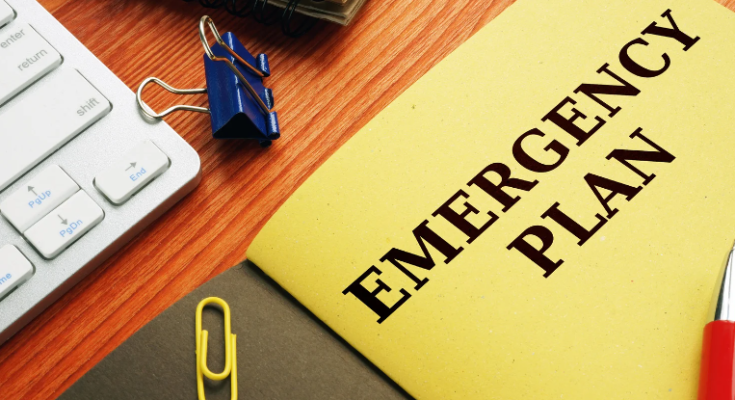The biggest thing about disasters is that these extraordinary events require special organizations and resources to tackle damage. Although special emergency measures are required, the requirements are predictable, and it is something that your business can prepare. Indeed, disaster planning is crucial for ensuring the safety of employees and minimizing potential damage during unforeseen incidents. Here’s a guide to help you draft or enhance your emergency plan with seven key elements, each vital for a comprehensive approach to emergency readiness.
The Significance of Emergency Preparedness

Emergency preparedness goes beyond reactive measures to include proactive planning to protect employees and maintain business continuity. This preparation includes establishing evacuation procedures, training staff, implementing security protocols and ensuring effective communication during emergencies.
Preparedness is not just about avoiding chaos – it is about creating a safe working environment that boosts morale, increases productivity and enhances your company’s reputation. With a well-thought-out plan in place, you can manage a crisis with confidence and efficiency, protecting both your employees and your business.
- Conducting a Risk Assessment
The foundation of any emergency plan is a comprehensive risk assessment. Each workplace is characterized by a distinct set of risks, which may include natural disasters, fires, chemical spills, or workplace violence. Conducting a detailed assessment enables the identification of these potential hazards, thus facilitating the adaptation of the emergency plan to address specific threats.
It is essential to evaluate all possible emergencies that may occur in a given location and within a specific industry. An understanding of these risks allows the development of targeted procedures that enhance the effectiveness of the emergency response.
Read Also: Understanding the Difference: Business Continuity Plan vs Contingency Plan
- Establishing an Emergency Response Team
The implementation of an effective emergency response strategy hinges on the establishment of a dedicated team. It is recommended that the Emergency Response Team (ERT) be comprised of trained individuals from various departments, each prepared to handle different emergency scenarios. The responsibilities of this team include the implementation of the emergency plan, the guidance of employees to safety, the coordination with emergency services, and the management of post-emergency recovery.
It is essential that the ERT undergo regular training in order to ensure their ability to act swiftly and efficiently in any situation, thereby guaranteeing the safety of all personnel within the workplace.
- Developing Clear Evacuation Procedures
A well-defined evacuation plan is essential for ensuring employee safety during emergencies. This includes mapping out clear evacuation routes, ensuring pathways are unobstructed, marking emergency exits, and designating safe assembly points outside the building.
Regularly audit the workplace to identify and remove potential obstructions. Additionally, integrating a digital visitor management system can provide real-time data on building occupancy, aiding in accurate headcounts during evacuations.
- Conducting Training and Drills
Your emergency plan is only as effective as your employees’ understanding of it. Regular training ensures that all staff members are familiar with emergency procedures, their specific roles, and how to respond to different types of emergencies. Comprehensive training should cover everything from initial alerts to post-evacuation steps.
Conducting regular drills is equally important. These simulations help employees practice their response, identify any procedural issues, and become comfortable with the evacuation routes.
- Establishing Reliable Emergency Communication
Effective communication during an emergency is crucial. Implementing a reliable communication system ensures that employees are promptly informed about emergencies and provided with necessary instructions. This system could include alarms, text alerts, public announcements, or other methods that quickly reach all employees, including those working remotely.
Must Read: Is Your Emergency Management Plan Costing You More Than It’s Worth?
Ensure that your communication is reliable and capable of delivering messages swiftly to everyone involved.
- Providing First Aid and Medical Assistance
First aid is a critical component of emergency preparedness. Having trained individuals who can administer immediate care can make a difference in the outcome of an emergency. These individuals should be capable of performing basic first aid tasks, such as CPR, stopping bleeding, and providing comfort to those in distress.
Maintain well-stocked first aid kits in easily accessible locations throughout the workplace. Regularly check and restock these kits to ensure all supplies are current. Consider having automated external defibrillators (AEDs) on-site for emergencies requiring them.
- Testing and Updating the Emergency Plan
An emergency plan should be a living document, continuously tested and updated to remain effective. Regularly test your plan to identify weaknesses or gaps. Gather feedback from employees involved in the drills to gain valuable insights and make necessary adjustments.
Review and update your emergency plan at least annually or more frequently if there are significant organizational changes. Staying prepared means continually refining your procedures to ensure they work when needed most.
Conclusion
Developing a comprehensive workplace emergency preparedness plan is not just a regulatory need but a strategic initiative that can save lives and protect your business. By following these seven essential elements, you can create a robust plan that ensures your workplace is ready for any emergency. Stay proactive, keep testing, and continually update your plan to maintain a safe and secure environment for everyone.



